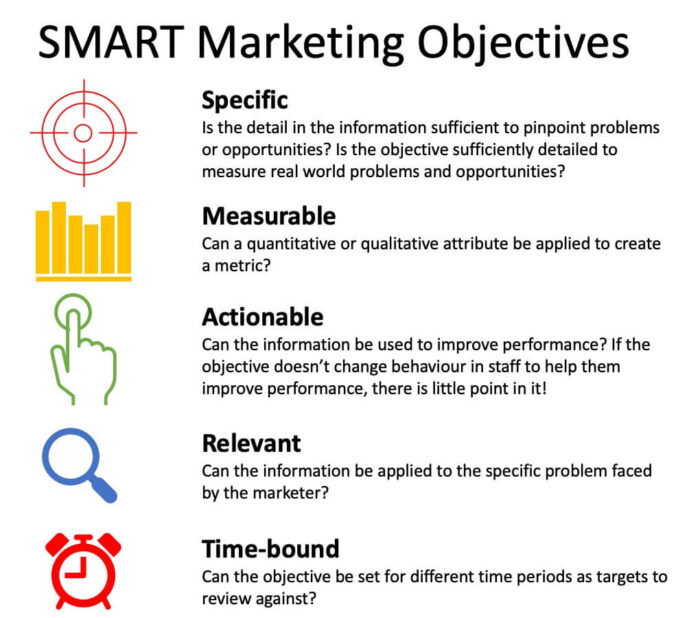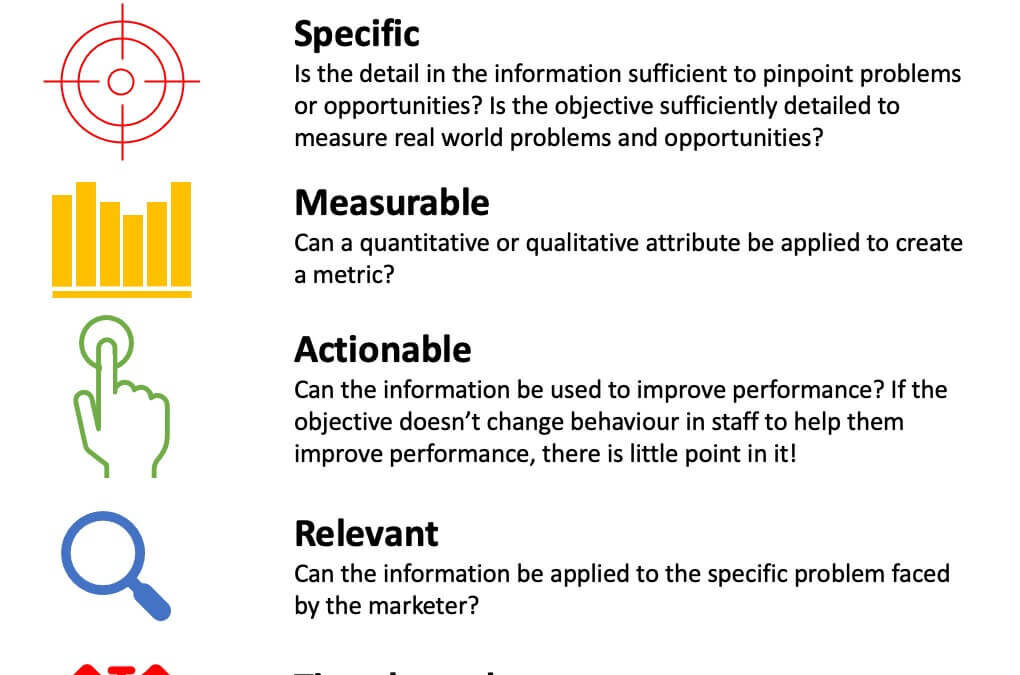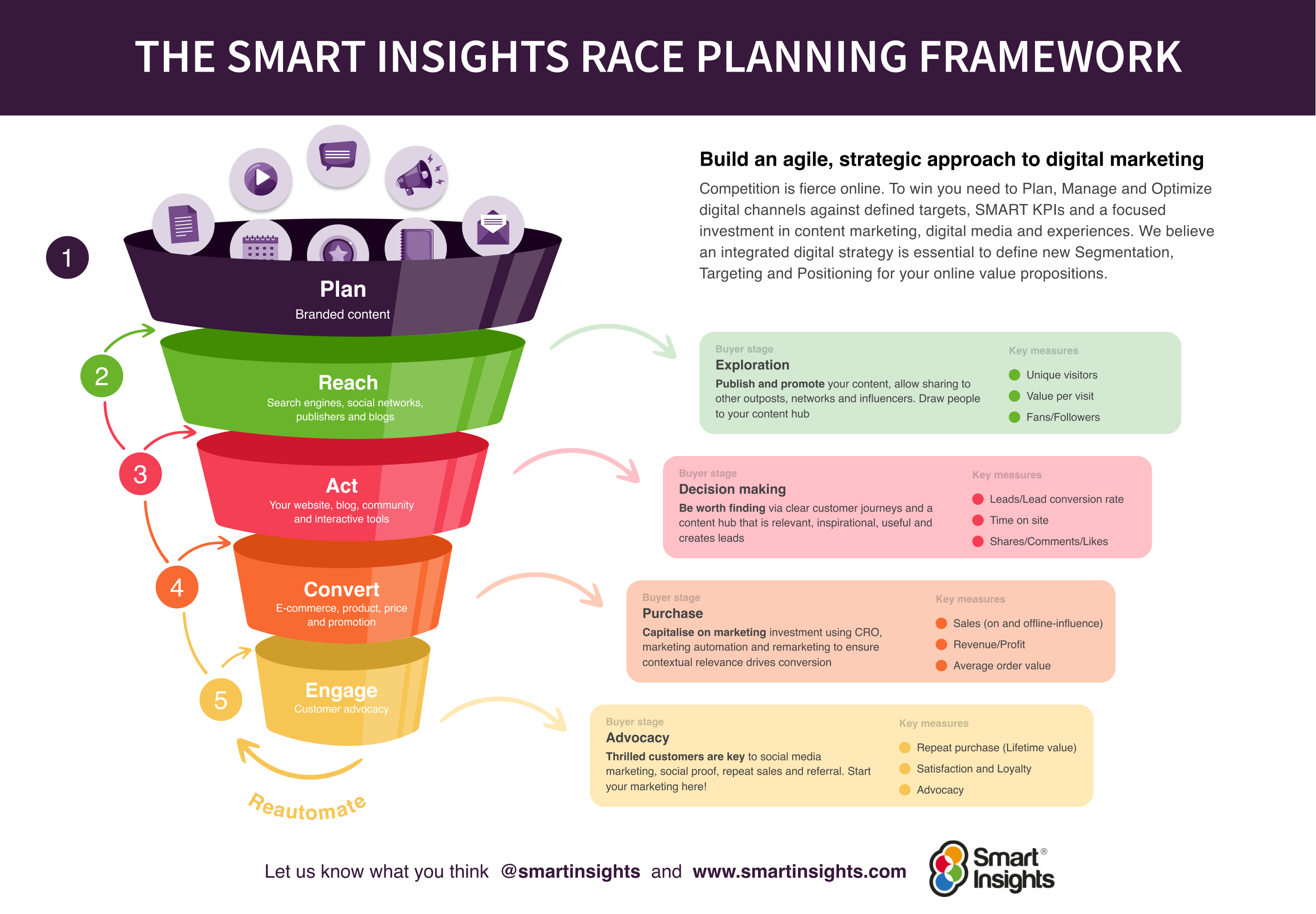From SMART to SMARTER marketing objectives: Discover how to define marketing objectives, measure your digital marketing goals, and use data to inform your marketing strategy
When identifying specific marketing objectives to support your long-term goals, it is common practice to apply the widely used SMART mnemonic. You will know that SMART is used to assess the suitability of objectives set to drive different strategies or the improvement of the full range of business processes.
By definition, an effective SMART marketing objective is:
Specific, measurable, actionable, relevant, and time-bound.
One of the main reasons we called our site and service SMART Insights is because we help marketers succeed with more structured approach to marketing strategy and planning.
Defining your marketing objectives
Our handy graphic summarizes the five different SMART components we recommend for your marketing objectives. Of course, different people interpret objectives differently. You can refer to the Wikipedia definition of SMART marketing objectives for more definitions.
Specific:
Does this objective have the potential to overcome real-world problems and unlock specific opportunities?
Measurable:
Is the result of this objective trackable/countable? What are the key metrics that will be used?
Actionable:
Will working towards this objective create positive change?
Relevant:
Does this objective align with your overall marketing strategy?
Time-bound:
What is the timeline for working towards and achieving this objective?

Keep your strategic objectives SMART, link your objectives to strategies and KPIs, and make sure all of your team know exactly what the target is.
Smart Insights have marketing tools and techniques to keep your team on track. Managers can utilize our advanced module forecast results and ROI for digital marketing activities, for Business Members, to set goals.
Plus, if you’re still looking for digital marketing buy-in, don’t forget to check out 10 reasons why you need a digital marketing strategy.
Examples of SMART marketing objectives
Here are some typical examples of SMART objectives. I’ve included one example across each stage of our RACE Growth System of Plan > Reach > Act > Convert > Engage. There are 2 examples for conversion objectives, as we know many businesses are setting new types of goals to help them navigate difficult commercial landscape.
- Audit objective: Review all in-house whitepapers relating to digital transformation and identify top 3 priorities to update next quarter.
- Digital traffic objective. Achieve 10% more traffic from a key channel or country within two years.
- MQL objective: Increase demo bookings from email channel.
- Acquisition objective. Acquire 50,000 new online customers this financial year at an average cost per acquisition (CPA) of £30 with an average profitability of £5.
- Conversion objective. Increase the average order value of online sales to £42 per customer.
- Engagement objective. Increase active customers purchasing at least once a quarter to 300,000 in a market (a hurdle rate metric).
Apply the RACE Framework to focus your marketing objectives on your customers experiences
Naturally, you will want to set different objectives to help you encourage your customers to take action at different stages in their purchase journey.
If you are raising awareness, your objectives and metrics will center around brand positioning, such as brand searches, and paid media impressions. Whereas conversion-related objectives could include CRO, VQVC, or email nurturing.
That’s where our RACE Framework comes in. A fully worked marketing and sales funnel including recommended marketing activities, KPIs, and integrations to help you plan a streamlined, effective customer journey.
We recommend integrating all your SMART marketing objectives across the RACE Framework, which you can follow below.
Our RACE Growth System has been designed to help you quickly create and action a 90-day marketing plan using the RACE Framework to improve your results from marketing.
By structuring your objectives across your customers’ lifecycle stages, you can measure granular metrics and customer-centric data to inform your goal setting and tracking.
With RACE, you’ll identify new opportunities, set objectives, optimize strategies, and take action to achieve your goals. Download your free guide now to find out more.
How can SMART objectives help set realistic goals?
When setting future digital marketing objectives, such as in a digital marketing plan, it’s useful to look hard at each measure and ask “can it be done?” and “will it help?”.
The SMART mnemonic helps as a test or filter which you can use to assess the quality of measures. The Smart Insights definition of SMART is:
- Specific – Can the detail in the information be sufficient to pinpoint problems or opportunities? Is the objective sufficiently detailed to measure real-world problems and opportunities?
- Measurable – Can a quantitative or qualitative attribute be applied to create a metric?
- Actionable – Can the information be used to improve performance? If the objective doesn’t change behavior in staff to help them improve performance, there is little point in it!
- Relevant – Can the information be applied to the specific problem faced by the marketer?
- Time-bound – Can objectives be set for different periods as targets to review against?
The Ten Measures Design Tests
You can add to your tests of choosing the right marketing objectives using these 10 measure design tests developed by performance management specialist Professor Andy Neely. For SMARTER metrics, ask these questions for your KPIs as you develop them.
- 1. The truth test. Are we measuring what we set out to measure?
- 2. The focus test. Are we only measuring what we set out to measure?
- 3. The relevancy test. Is it the right measure of the performance measure we want to track?
- 4. The consistency test. Will the data always be collected in the same way whoever measures it?
- 5. The access test. Is it easy to locate and capture the data needed to make the measurement?
- 6. The clarity test. Is any ambiguity possible in interpreting the results?
- 7. The so-what test. Can and will the data be acted upon, i.e. is it actionable?
- 8. The timeliness test. Can the data be accessed rapidly and frequently enough for action?
- 9. The cost test. Is the measure worth the cost of measurement?
- 10. The gaming test. Is the measure likely to encourage undesirable or inappropriate behaviors?
These tests show there are additional filters on top of SMART that are useful to choose the best measure. I particularly like the “So-what test, another way of explaining relevance and Gaming – a common issue with target setting that isn’t considered by SMART!
Plus, check out our top 18 digital marketing techniques to ensure you are covering the key areas of digital marketing that are relevant today.
Alternative SMART objectives definitions
Finally, some have developed the SMARTER objectives definition that shows the need to re-examine the relevance of SMART objectives over time.
This definition certainly shows the many alternative digital marketing objectives definitions – you may want to compare your current approach against these!
| Letter | Most Common | Alternative |
|---|---|---|
| S | Specific | Significant, Stretching, Simple, Sustainable |
| M | Measurable | Motivational, Manageable, Meaningful |
| A | Attainable | Appropriate, Achievable, Agreed, Assignable, Actionable, Adjustable, Ambitious. |
| R | Relevant | Results-Based, Results-Oriented, Resourced, Realistic, Reasonable. |
| T | Time-Bound | Timed, Time-Framed, Time-Specific, Timetabled, Time-limited, Trackable, Tangible. |
| E | Evaluate | Ethical, Enjoyable, Engaging, Evidenced |
| R | Reevaluate | Reviewed, Rewarded, Revisit, Recordable, Rewarding, Reaching. |
Set and achieve your business SMART objectives
Now that we’ve defined what SMART objectives mean for you and your marketing strategy. What are your next steps, and how can you ensure you achieve your goals.
We’ve got a library of ready-to-go marketing strategy tools and templates, all integrated across the RACE Framework, to support you:
- Setting your marketing objectives
- Tweaking and improving your marketing activities in line with your goals
- Managing your team and accelerating results
- Applying data and customer insights to constantly review and adapt your strategies and tactics
Whether you want to improve your Google Analytics skills, train your team, or apply new data-driven templates for growth forecasting, we recommend using our RACE Growth System to springboard your marketing from strategy into action.
All our marketing solutions are integrated across RACE so you can confidently apply your findings to improve your marketing across one, some, or all of the stages of your customer lifecycle.
Through RACE, you can identify new opportunities at every stage of your marketing cycle and prioritize the key journeys that drive the results you need. Download your free RACE Growth System guide to learn how you could grow your business with Smart Insights.


